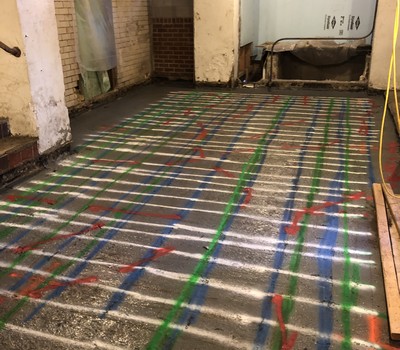RainierGPR Service Areas: Expert Concrete Scanning in Your Region
RainierGPR Service Areas: Expert Concrete Scanning in Your Region
Blog Article
Concrete Scanning: An Important Step Towards Making Sure Architectural Integrity and Safety
In the realm of construction and facilities upkeep, the relevance of concrete scanning can not be overstated. This precise process holds the vital to introducing prospective dangers hidden underneath the surface area of relatively solid frameworks. By employing sophisticated innovation and approaches, concrete scanning serves as a crucial tool in ensuring that the stability and security of bridges and buildings are promoted to the greatest standards. Nonetheless, past its surface-level ramifications, the role of concrete scanning expands far deeper than meets the eye.
Importance of Concrete Scanning
Concrete scanning plays an essential duty in guaranteeing the architectural honesty and security of structures and infrastructure jobs. By using advanced innovations such as ground-penetrating radar (GPR) and electromagnetic induction, experts can non-destructively evaluate concrete frameworks to spot possible defects, spaces, ingrained things, and reinforcement design. This procedure enables early detection of anomalies that can compromise the stability of a framework, avoiding costly problems and guaranteeing the safety and security of occupants.
Concrete scanning is particularly essential during the planning and building and construction phases of a task. Prior to drilling, cutting, or coring into concrete, scanning assists determine the specific areas of rebar, post-tension cords, and other embedded aspects, lowering the risk of unexpected hits that can lead to architectural weaknesses. Additionally, concrete scanning help in quality assurance by confirming the thickness of concrete covers and detecting any inconsistencies that might impact the general sturdiness of the framework. Inevitably, spending in concrete scanning solutions is not only a positive measure to mitigate threats yet additionally a fundamental action in the direction of maintaining the long-term safety and stability of buildings and framework.
Technology for Concrete Evaluation

Benefits of Early Detection
Timely discovery of architectural issues can dramatically mitigate threats and make sure the long life of construction jobs. By determining potential issues early on in the construction process, stakeholders can take aggressive steps to resolve issues before they escalate into larger and extra costly problems. One of the key benefits of early discovery is the prevention of structural failures, which can position significant safety and security dangers and bring about task hold-ups and economic losses.
Moreover, very early discovery enables prompt fixings and maintenance, which can help expand the life-span of the framework. By addressing issues promptly, construction groups can stay clear of expensive repair work or perhaps the requirement for premature replacement of structural components. This proactive strategy not just saves time and cash however likewise enhances the total security and durability of the building project.
In addition, early detection can improve project preparation and decision-making by supplying stakeholders with important understandings right into the problem of the framework. Armed with this details, job managers can make informed selections relating to construction approaches, materials, and timelines, bring about a lot more effective and effective task results.
Guaranteeing Structural Security
Making sure the structural security of a construction project is vital to its safety and long life. Architectural stability describes the ability of a building Bonuses or framework to maintain its type and feature under environmental problems and numerous loads. To achieve this, comprehensive assessment and tracking of the framework are see page important. Concrete scanning plays a crucial role in making certain structural stability by finding potential problems such as voids, delamination, or reinforcement rust that can compromise the integrity of the framework gradually.
By making use of advanced scanning technologies like ground-penetrating radar (GPR) and electro-magnetic induction, construction experts can non-invasively check concrete structures to determine areas of concern beneath the surface. This proactive approach permits the very early detection of problems or weaknesses, enabling prompt repair services or support to avoid structural failures.
Routine concrete scanning during various building phases and throughout the life cycle of a framework can aid preserve its stability, mitigate threats, and make certain the safety of occupants. By focusing on structural stability through concrete scanning, construction jobs can enhance their resilience and toughness, eventually adding to higher safety and long life.

Preventing Vital Failures
To guard against catastrophic occasions, meticulous monitoring and positive upkeep are imperative in avoiding critical failures within architectural frameworks. Identifying prospective problems before they rise is essential to stop architectural failures. Carrying out routine assessments, such as concrete scanning, can reveal surprise defects like voids, splits, or corrosion that might jeopardize the integrity of a structure. By making use of advanced scanning modern technologies like Ground Permeating Radar (GPR) or Concrete X-ray, designers can non-destructively examine the condition of concrete and determine weak factors that call for reinforcement or fixing - RainierGPR Service Areas.

Verdict
In final thought, concrete scanning plays a critical role in making sure structural stability and security by making use of sophisticated technology for early discovery of potential issues. This positive method assists stop important failings and guarantees the stability of structures. It is necessary to focus on concrete examination as a standard practice to safeguard the longevity and safety of structures and facilities.
Concrete scanning plays an essential role in guaranteeing the structural honesty and security of buildings and facilities jobs. Additionally, concrete scanning help in top quality control by confirming the thickness of concrete covers and discovering any type of discrepancies that might impact the total longevity of the framework. Concrete scanning plays a critical function in ensuring architectural stability by spotting prospective problems such as voids, delamination, or reinforcement deterioration that can endanger the integrity of the framework over time.
In conclusion, concrete scanning plays an essential role in making sure architectural honesty and safety and security by making use of innovative modern technology for early discovery of possible concerns.
Report this page